We left Galway and drove north into the Connemara. The Connemara region of western Ireland has spectacular scenic views, with rolling hills and deep lakes. This area is also home to the largest Irish-speaking population in the country. I spent the trip staring out the window at the awesome scenery.
For lunch we stopped at this sleepy little village:
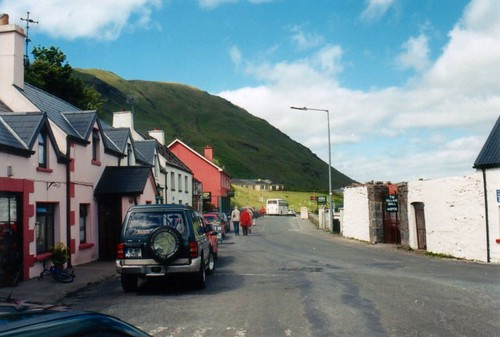

And the view of the Connemara, from the window of the tour bus:
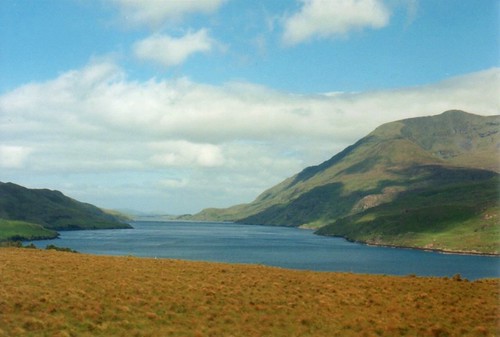
Our next stop was the amazing Kylemore Abbey, which sits alongside a lake and is nestled under several huge hills.

Construction on the Abbey ended in 1868, and it was built as the private home for an English politician from Manchester who was the MP for Galway County. After his wife died, he sold what was then called Kylemore Castle to a group of Benedectine monks who were escaping Belgium during World War I. The Abbey now serves as a monastery and a girl's boarding school.

The view from the front of the Abbey:
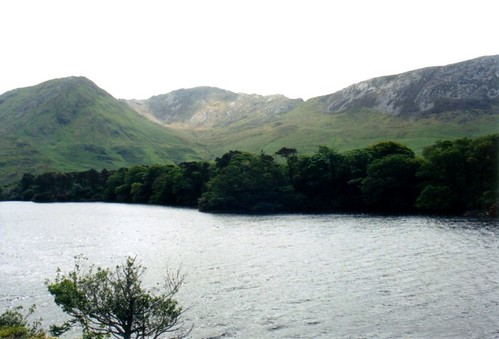
Another feature of the Abbey is the neo-Gothic church, built between 1887 and 1881. The church is a replica of the Norwich Cathedral in England.
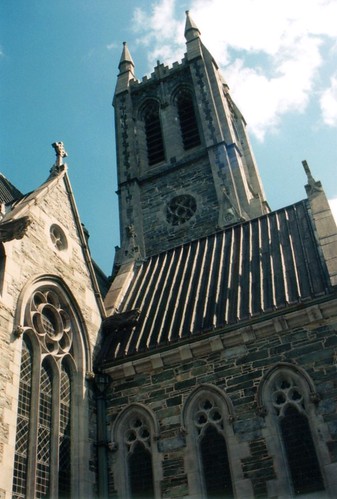
And the view on the inside:
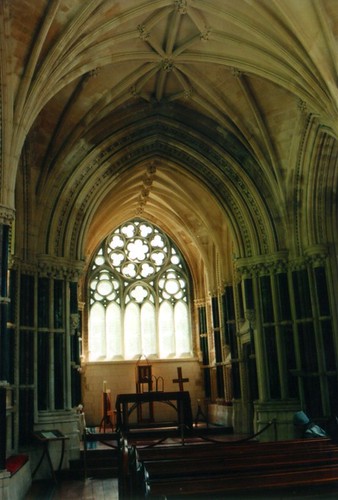
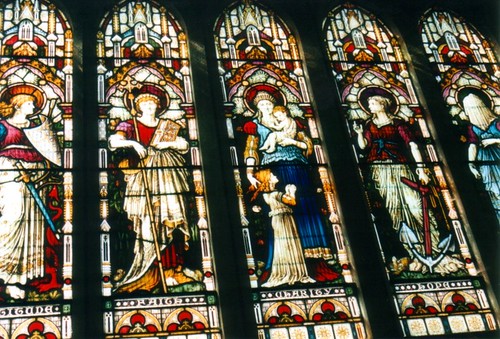
Kylemore Abbey is an awesome place, I can't imagine what it must be like to attend school there.

As we were driving away from the Abbey, the driver stopped the bus in the middle of the road. He said we were at a pretty spot, and if anyone with a camera would hurry, they could get a quick shot. So I quickly made my way to the front of the bus and got this shot through the windshield.

After that we drove further north to the city of Sligo.

We made the short drive over to the Drumcliffe graveyard, which is the final resting place for the Irish poet William Butler Yeats.

Yeats was the first Irishman to win the Nobel Prize for literature in 1923, just after Ireland gained its independence from England. He was a driving force behind the Irish Literary Revival, and even served two terms in the Irish Senate. His epitaph is taken from the last lines of "Under Ben Bulben", one of his final poems:
Cast a cold Eye
On Life, on Death.
Horseman, pass by.
While we were there, another large tour bus pulled up. The tourists emptied out of the bus and walked around the cemetery. "Where are we now?" one of them said loudly. "At the grave of W.B. Yeats," came back the answer. The same person said, "Who is that," and when she was told it was a famous poet, she just turned around and walked back to the bus.
How rude, I thought. Even if you weren't familiar with who Yeats was (our class had at least read some of his work before the trip), you should show some respect to the cemetery, at least. It is a pretty little cemetery, overlooked by the nearby Ben Bulban Mountain.
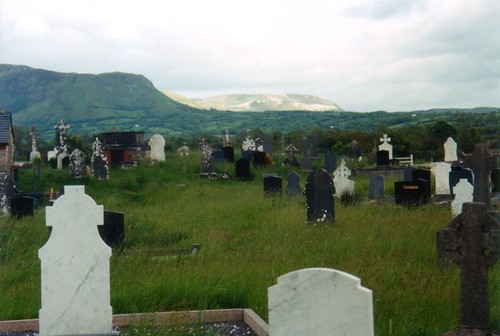
There was even a neat old church and high cross there, too.
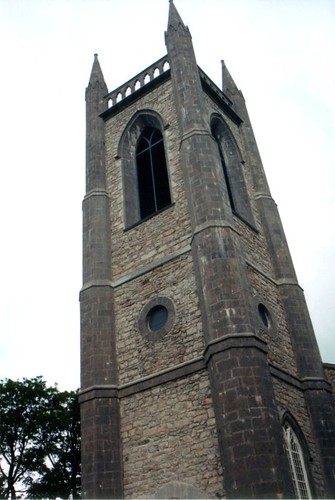
From there we headed on to Rosses Point, a peninsula in the Atlantic Ocean where William Butler Yeats and his brother spent their summers. It was another scenic spot.
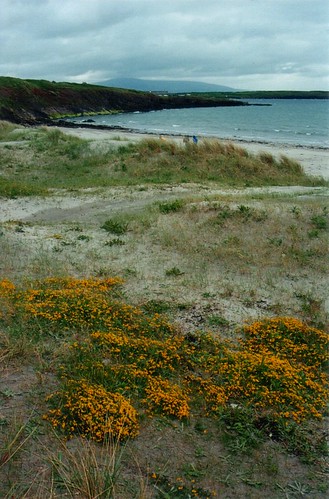
We went back into Sligo so we could get some dinner. Sligo is also a neat little town.
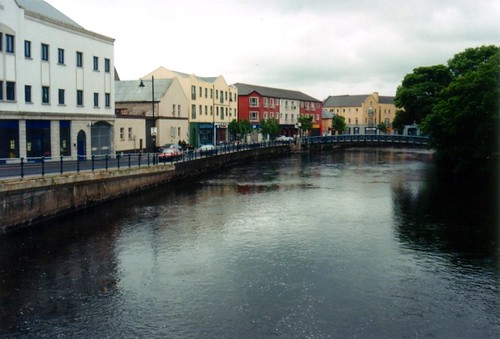
Sligo's name comes from the Irish Sligeach,meaning "shelly place" because of the large number of shellfish found in the river and estuary.
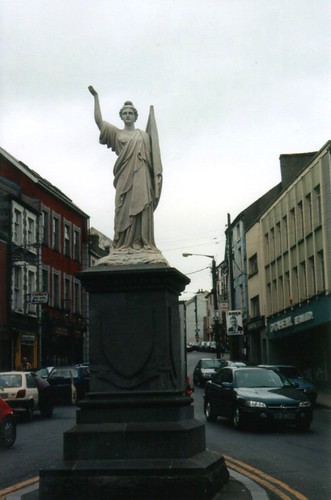
A castle was built here in 1245, but the town was often attacked and burned during the medieval period. The only medieval building left in Sligo is Sligo Abbey (which we didn't get to see). Bram Stoker's mother was from Sligo, and it's said that ghost stories he heard about the Sligo Abbey were the inspiration for Dracula.
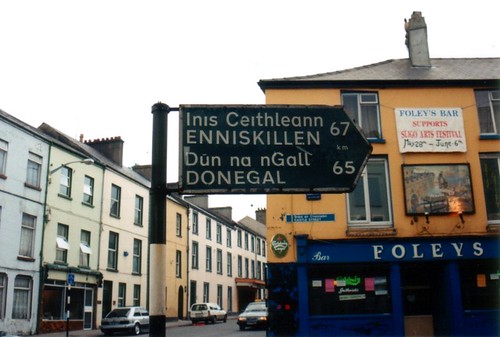
It was one of our last days in Ireland, and we spent the night at a bed and breakfast.
Sunday, May 30, 1999:
We left Sligo early that morning, and then drove across Ireland to Dublin. I was amazed that we drove all the way across an entire country in just a few hours. But we had the entire afternoon as free time, where we could visit any sights in Dublin that we wanted to.
Our first stop was St. Patrick's Cathedral - the largest church in Ireland. The church is built near a well that St. Patrick used to baptise converts, and the the current cathedral was built between 1200 and 1270. When Oliver Cromwell was in Dublin, he stabled his horses in the nave of the cathedral. The church underwent a major renovation in the 1860's, funded by the Guinness family.
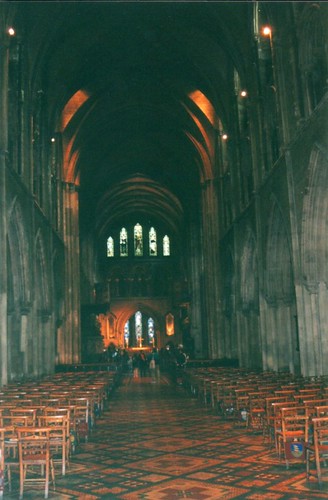
Hanging above the pews are hundred of flags, which were carried by Irish troops during battles.
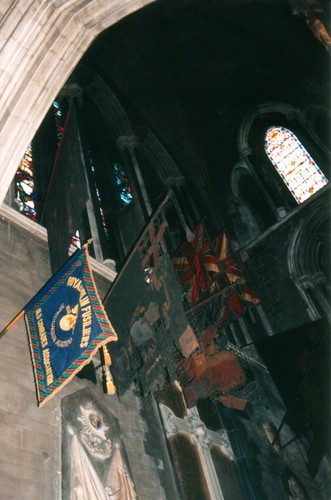
There are a lot intricately designed stained glass windows in the cathedral.

But this one was my favorite of the stained glass windows:

Why is it my favorite? Because it shows King Cormac (my long lost relative?)

Our bus driver was kind enough to give us a lift back over to Trinity College, and we began a walking tour of Dublin. We passed by the statue of Molly Malone, the fishmonger featured in Dublin's anthem, Molly Malone:
In Dublin's fair city,
where the girls are so pretty,
I first set my eyes on sweet Molly Malone,
As she wheeled her wheel-barrow,
Through streets broad and narrow,
Crying, "Cockles and mussels, alive alive oh!"
Dubliners have given the many statues in their fair city some nicknames, and this statue of Molly Malone is referred to as the "tart with the cart."
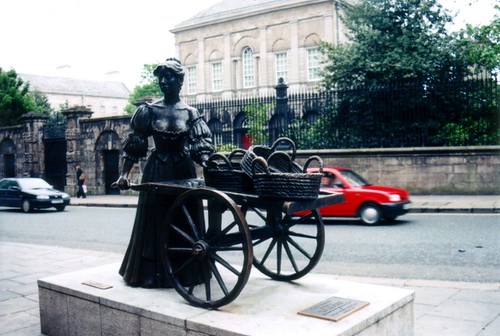
At College Green, near the front entrance to Trinity College, sits this view. On the right is the Bank of Ireland building, which served as Ireland's Parliament House until 1800.
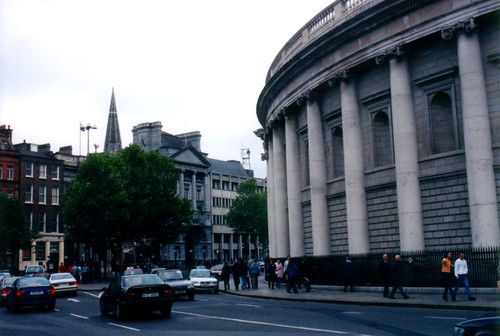
From there we walked up the busy O'Connell Street...
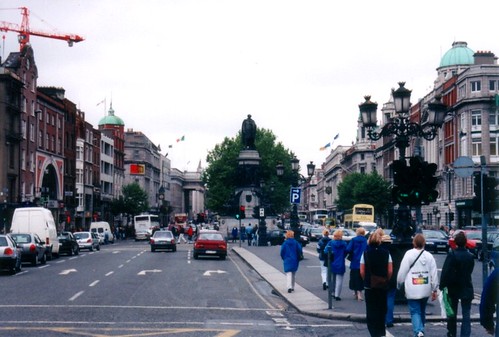
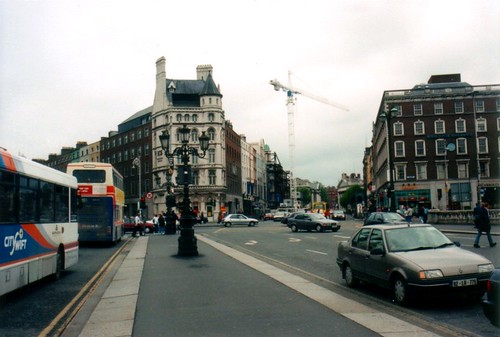
The view of the River Liffey from the middle of the O'Connel Street Bridge:

We walked by the General Post Office, the sight of the 1916 Easter Rising. It was from here that Patrick Pearse read out the Proclamation of the Republic, which proclaimed independence from England. The rising was suppressed seven days later, after the English began to bombard the area around the GPO. Fires caused by the shelling caused the Irish rebels to dig tunnels from the GPO and through neighboring buildings. On April 29,1916, the rebels surrendered.

The GPO was heavily damaged during the rising, and you can still see bullet holes on the columns along the front of the building. But the Easter Rising brought about a growing desire for Irish Independence, and the Anglo-Irish treaty of 1920 divided Ireland into the Republic of Ireland and Northern Ireland.
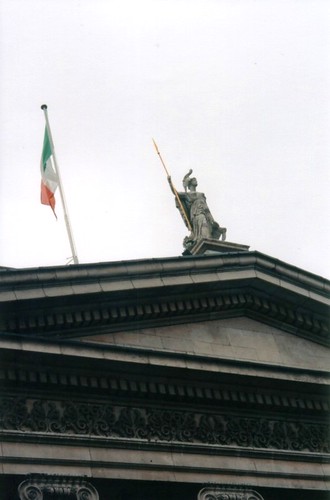
Outside of the GPO sat the Anna Livia fountain, which was meant to personify the River Liffey. Dubliners loving named this statue the "Floozie in the Jacuzzi."
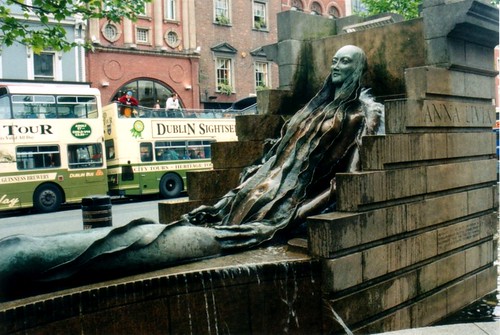
This statue sat on the spot of Nelson's Pillar, which was built in 1809. The pillar included a statue of Lord Nelson that was similar to the statue in London's Trafalgar Square. In 1966, an IRA bomb destroyed the statue and damaged the pillar, and it was taken down. The Anna Livia fountain was built in 1988, and moved in 2003 to make way for the Dublin Spire.
Walking down O'Connell Street we passed by this statue of James Joyce, which Dubliners lovingly refer to as "the prick with the stick."

Then we had one of the most bizarre encounters of the trip. We hadn't had lunch yet, and looked for someplace to get a quick bite to eat. We were right next to a Burger King, and we reluctantly went in (none us really wanted to travel abroad and then eat at an American fast food place). But I'm glad we did.
We all stood in line, trying to figure out what to get. Someone in line ahead of us looked a bit familiar. After he walked past, we tried to figure out who it was. One of us remembered where we had seen him before - he was the guy who played Frank Fontana on Murphy Brown! We debated back and forth on whether or not it really was him or not. Some other Americans were behind us in line and overheard us talking, and they said they thought it was him as well.
I was the last one in line, and while I waited for my food, my friends walked over to talk to Frank Fontana, whose real name is Joe Regalbuto. They said that they were just able to ask, "excuse me, are you.." before he cut them off and said that yes he was. They said he was nice and signed some autographs. I was a bit dissapointed that they did this while I was waiting to get my food.
But we sat down and started to eat, across the dining area from the table where Joe Regalbuto was sitting with three other people. As we finished our meals, we kept on trying to discreetly look over at the table with the famous person at it. There was another person there who also looked familiar. Who was that?
Then suddenly it dawned on us, that person looks like Steven Spielberg! No way, I thought, what would he be doing at a Buger King of all places? There was a security guard walking around, talking importantly into a walkie-talkie. So we asked him, "excuse me, is that Steven Spielberg sitting over there?" And he answered simply, "why yes, it is."
Holy crap! I took the camera out and tried to get a shot without anyone noticing. I feel bad since I felt like a paparrazi. But I didn't think anyone would believe me without any proof of the encounter.

When they had finished eating, we decided to go and have a quick chat with them. Steven Spielberg didn't seem like he wanted to be recognized, so he didn't say much. But one of my friends said that he really liked Schiendler's List, which made Speilberg look up and smile, and say thanks. I tried to say something but I was nervous and ended up mumbling something incoherent that probably made me look like a crazy person. We went off and let them enjoy the last of their fries in peace.
And actually, Steven Spielberg wouldn't be the last celebrity we saw in Dublin that day. Right by the GPO, we also spotted Herbie:
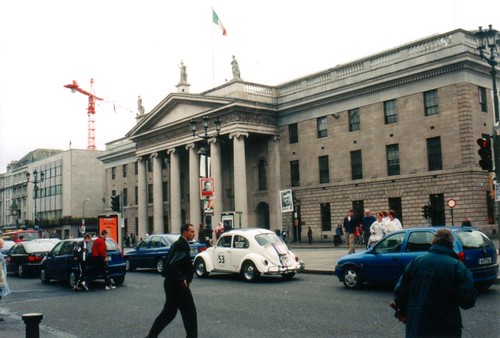
We were running out of time though. We had to meet back up with the bus soon, but I rushed into a sporting goods store along O'Connell street to do some last minute shopping. At the pub earlier on the trip, I saw someone wearing what I thought was the jersey for Dublin's soccer team. I hurried and tried to find it in the store, and quickly purchased one. I later found out that it wasn't a soccer jersey but was instead the jersey for Dublin's Gaelic Football team. Oh well, it's a pretty cool looking jersey anyways.
Now we were really pressed for time. But we wanted to go out and see the Ha'penny Bridge, which crosses the River Liffey. We ran down the road and up to the bridge.
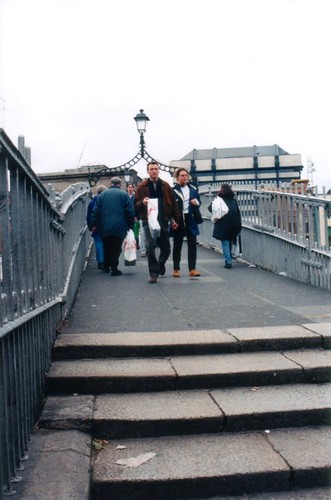
The Ha'penny bridge is a pedestrian bridge over the River Liffey, built in 1816. The name comes from the toll that was charged to cross the bridge when it was built - half a penny. It's free now to go across the bridge. The views from the bridge:
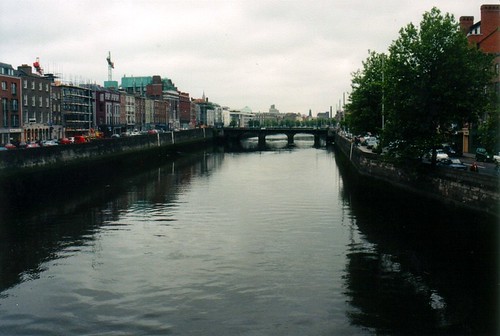

The bus was waiting for us by Trinity College, so we hurried over to meet it. I quickly got a few shots along the way. This was from under the columns of the Bank of Ireland building:

And Trinity College:
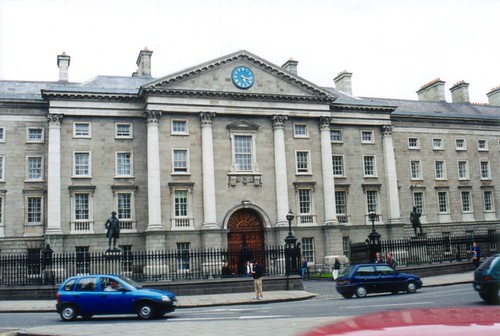
The bus was waiting at the college, and I got this one last shot before getting on board.
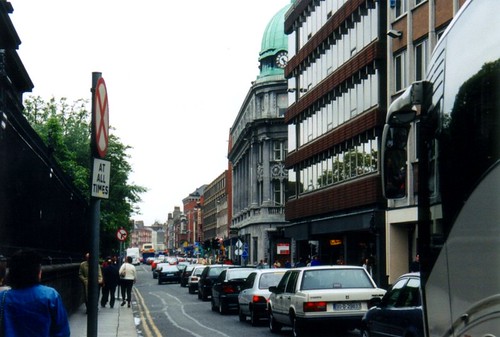
On the bus we proceeded to tell the rest of the class about our celebrity sightings. The bus driver tried to interupt so he could give out some facts about Dublin while he was driving around. But by the end of our story, he was anxious to share his celebrity sighting of the day. He said he went to a pub for lunch, and sat down right next to Tom Selleck. He said that the two of them had a nice talk while they ate their lunches.
Eventually we were dropped off and met up one last time with our Dublin host families. This was our last day in Ireland, so we went out to the pubs for one final night. We tried to enjoy it as much as we could, and stayed until the pub closed. It probably wasn't a good idea, since we had to meet the bus in the morning for the ride to the airport. Luckily for me and two friends, we still had a few more days of sightseeing to do...


No comments:
Post a Comment